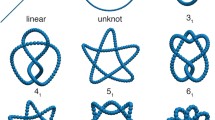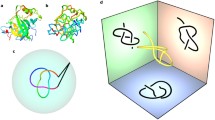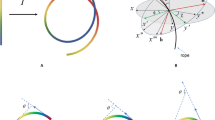Abstract
The shortest tube of constant diameter that can form a given knot represents the ‘ideal’ form of the knot1,2. Ideal knots provide an irreducible representation of the knot, and they have some intriguing mathematical and physical features, including a direct correspondence with the time-averaged shapes of knotted DNA molecules in solution1,2. Here we describe the properties of ideal forms of composite knots — knots obtained by the sequential tying of two or more independent knots (called factor knots) on the same string. We find that the writhe (related to the handedness of crossing points) of composite knots is the sum of that of the ideal forms of the factor knots. By comparing ideal composite knots with simulated configurations of knotted, thermally fluctuating DNA, we conclude that the additivity of writhe applies also to randomly distorted configurations of composite knots and their corresponding factor knots. We show that composite knots with several factor knots may possess distinct structural isomers that can be interconverted only by loosening the knot.



Similar content being viewed by others
References
Katritch, V. et al. Geometry and physics of knots. Nature 384, 142–145 (1996).
Stasiak, A., Katritch, V., Bednar, J., Michoud, D. & Dubochet, J. Electrophoretic mobility of DNA knots. Nature 384, 122 (1996).
Rolfsen, D. Knots and Links (Publish or Perish, Berkeley, CA, (1976)).
Fuller, F. B. The writhing number of a space curve. Proc. Natl Acad. Sci. USA 68, 815–819 (1971).
Fuller, F. B. Decomposition of the linking number of a closed ribbon: a problem from molecular biology. Proc. Natl Acad. Sci. USA 75, 3557–3561 (1978).
Janse van Rensburg, E. J., Orlandini, E., Sumners, D. W., Tesi, M. C. & Whittington, S. G. The writhe of knots in the cubic lattice. J. Knot Theory Ramif. 6, 31–44 (1997).
Calugareanu, G. L'intégral de Gauss et l'analyse des noeuds tridimensionnels. Rev. Math. Pur. Appl. 4, 5–20 (1959).
Vologodskii, A. V., Levene, S. D., Klenin, K. V., Frank-Kamenetskii, M. & Cozzarelli, N. R. Conformational and thermodynamic properties of supercoiled DNA. J. Mol. Biol. 227, 1224–1243 (1992).
Pieranski, P. Search of ideal knots. ProDialog 5, 111–120 (1996).
Acknowledgements
This work was supported by the US Public Health Service, the Polish Committee of Scientific Research, the Swiss National Foundation and by Foundation Herbette, University of Lausanne. We thank R. Scharein for making available his KnotPlot program.
Author information
Authors and Affiliations
Corresponding author
Rights and permissions
About this article
Cite this article
Katritch, V., Olson, W., Pieranski, P. et al. Properties of ideal composite knots. Nature 388, 148–151 (1997). https://doi.org/10.1038/40582
Received:
Accepted:
Issue Date:
DOI: https://doi.org/10.1038/40582
- Springer Nature Limited
This article is cited by
-
Knot integrity using different suture types and different knot-tying techniques for reconstructive pelvic floor procedures
International Urogynecology Journal (2018)
-
Optimal shapes of compact strings
Nature (2000)
-
Four-thirds power law for knots and links
Nature (1998)





